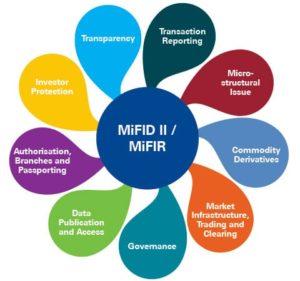Data Governance Policies Need To Be Updated
MiFID II is a new exhaustive financial regulation being implemented in Europe as of January 3rd. However, the sweeping legislation won’t only impact European banks.
Even U.S. financial institutions are grappling with the changes as they race to implement the necessary changes globally. Also, current U.S. regulations conflict with some of the new guidelines in Europe making adherence by U.S. institutions complicated and costly.
According to The American Banker, U.S. and European institutions are spending $20 billion in technology improvements to achieve compliance with MiFID.
Given the global reach of capital markets, U.S. firms will come in contact with MiFID II. If a U.S. firm has EU advisers, they will be considered an EU investment firm or entity and be subject to the regulations. Also, if a U.S. firm deals with European brokers, trade on the European markets, they will have to comply to regulators of MiFID II. For example, trading limits will have to be adhered to particularly for commodities. System upgrades will be needed to comply with rules surrounding data storage and data availability to clients and regulators.
What is MiFID II?
The overall goal of MiFID is to ensure the financial markets, transactions and the reporting of the activity are more transparent and fairer to investors and clients of financial institutions.
However, in addition to increasing transparency for investors, the legislation also enhances the ability of regulators to see transaction activity of trading desks that has long eluded them. The added insight allows regulators to monitor institutions more efficiently, spot abuses sooner, and identify non-compliance earlier than ever before.
The Extensive Impact Of MiFID II
 If your institution is a bank, non-bank or asset manager, if your firm is engaged in advisory services, equity trading, derivatives trading, or trading activity, in Europe MiFID II impacts your company. Even data-services providers, high-frequency trading firms and brokers of any kind are impacted by the new laws. Although the legislation is over 7,000 pages long, we’ll cover the key aspects that are likely to affect financial institutions.
If your institution is a bank, non-bank or asset manager, if your firm is engaged in advisory services, equity trading, derivatives trading, or trading activity, in Europe MiFID II impacts your company. Even data-services providers, high-frequency trading firms and brokers of any kind are impacted by the new laws. Although the legislation is over 7,000 pages long, we’ll cover the key aspects that are likely to affect financial institutions.
Recorded Keeping:
Any firm in the financial services industry that provides advisory services over the phone or in-person must document the calls and their meetings. If an advisor speaks with a client over the phone providing advice or booking a trade or transaction, those calls need to be recorded and stored safely. Also, face-face meetings with clients are required to have minutes taken to document the discussion and those minutes need to be stored and easily retrievable.
Adhering to MiFID II will involve significant investment in recording technology, electronic-data storage, and physical record-keeping. Internal policies and controls will need to be established that address how data will be recorded and stored, but also how that data will be properly destroyed to be compliant with MiFID II.
Investment Research:
The “unbundling” of research services is another component of MiFID II. Investment banks must now charge for research and brokerage services separately. In the past, these services were bundled together.
“Sell-side” firms that provide trading and investment research charge fees to “buy-side” firms or asset managers. However, the fees were often built into the bid/offer spreads for executing trades for those asset managers. As a result, fund managers would get research freely for doing their trading business with the sell-side firm.
MiFID II requires sell-side firms to unbundle their fee structure for trading and research services. As a result, a systematic process must be established showing how research firms charge, by how much, how the research is used, and in what quantities. Monthly and quarterly tracking must be implemented by both buy and sell-side firms showing what research was consumed, the amounts charged or paid, and who was the end user.
The regulatory change forces sell-side firms to look inward and value their research, the labor-time involved in developing their research, and determine a fee structure to charge asset managers. The result may foster greater competition from independent research firms that may now be able to compete with the likes of Goldman Sachs to provide fund managers investment analysis.
One of the goals of MiFID II is to unbundle research creating an environment where clients get the best execution for their trades while separating out how asset managers buy their investment research.
Data governance includes end-to-end planning for maintaining, storing, and removing data that are transparent and easily reportable to both customers and regulators. With the passage of MiFID II, data management on an enterprise-wide level is now critical to remaining compliant. Technological investments will be needed to upgrade systems in the event legacy systems are not adequate.
Digital Storage
The way client data is stored so that it can be easily accessed as a result of requests from clients and regulators will prompt financial firms to assess their existing data storage policies and invest in upgrading their digital infrastructure.
Under the MiFID II requirements, the proper destruction of old data is required to remain compliant. Whether data disposal is performed in-house or by an outside firm, financial institutions will need to ensure a transparent chain of custody is established for the data. According to MiFID II, data storage will need to be retained for five years for any client requests and seven years for regulators.
Legacy Systems Versus New Technologies
Since how data is stored, reported, and disposed of is so critical to compliance of MiFID II, financial institutions will have to perform assessments of their existing legacy systems to determine whether they can handle the increased data workload. Often systems are silo driven resulting in an inability to communicate with each other. Many institutions have legacy systems from past mergers whereby it was deemed cost-effective to keep the cheaper system. Rigorous testing is needed to determine if those legacy systems will be adequate for proper data management, storage, and reporting to regulators. If not, technology upgrades to will be needed to capture data ranging from trading activities to post-trade reporting to client activity.
Oversight Of Data Management Procedures
Data management procedures will need to be tested and new processes implemented that ensure transactions at any point in the life cycle can be retrieved for regulators. Data lineage allowing an institution to reconstruct historical trades, determine its origin, and track its process over time, will be necessary for reporting to regulators. Any delay or inability to report in the time required may result in fines.
Transaction Reporting Of Trades
Reports must be sent to regulators promptly. Trade reports required by regulators need to be submitted on the same day the trade is made. Also, post-trade reporting including timestamps on all trades must be systematic and accessible to regulators. All types of data in its life cycle will need to be easily retrievable for regulators and clients. Institutions should complete an enterprise-wide assessment of whether their existing regulatory reporting systems perform as required under MiFID II. Those systems will be required to adapt to future changes in the regulatory landscape.
Going Forward:
For many firms, ensuring they have the infrastructure and processes in place with end-to-end data governance and timely and effective communication to clients and regulators will be just a few of the challenges that lie ahead.
An efficient data-governance framework can ensure a high-level of data quality enterprise-wide. Given the technical standards required by MiFID II, investing in technology solutions will be the most significant change for institutions. However, these investments can lead to improved data governance that supports end-to-end planning for new processes, proper data storage and disposal, and transaction monitoring. The ideal result includes a transparent process on a holistic level that can help institutions meet MiFID II requirements.
Related Posts
October 17, 2020
Case Study : Implementing an integrated risk management approach for an investment bank
Just the other day I happened to wake…


